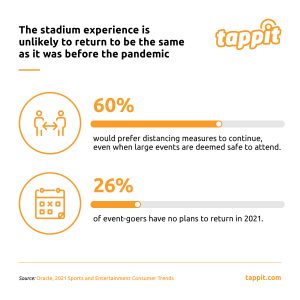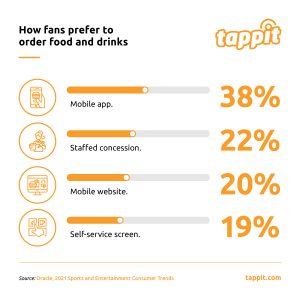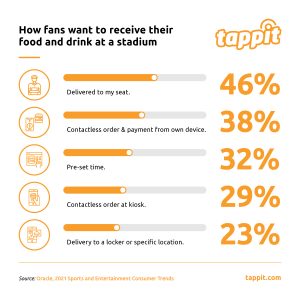It’s over a year since most sports fans have attended a game, cheered their team on and taken in the collective experience that makes live events so special.
In that time, the global pandemic has resulted in huge shifts in consumer behaviour and expectations across many industries and the sports industry is no exception.
Covid-19 exposed the fragility of the sports industry. Many sports stadiums found without game day revenue they had no other means of generating revenue.
Now, as many countries move into the recovery phase and stadiums are reopening, have sports fans’ expectations changed over the last year? Has Covid resulted in a permanent shift in consumer behaviours? And if so, what do sports stadiums need to do to be a success in the future?
Oracle recently produced a report into consumer trends in sports and entertainment titled Back in the Arena.
Unsurprisingly, they found that people have really missed live events and are looking forward to returning when it’s safe to do so. Even so, the percentage of customers that plan to go back to stadiums once it’s safe is relatively low at 26%. When Tappit ran a survey of 1,000 US sports fans in January of this year, we got a similar result, with 27% of fans looking forward to going back to a sporting event in the next six months.
In the UK and US the vaccination programme is well underway, however some hesitancy is clear. This is especially true for boomers who are the least likely to return to live events according to Oracle’s research, with 43% planning to stay away for the rest of 2021.
In Tappit’s survey, when we asked fans which physical measures are essential to reassure them that it’s safe to attend a game, 78% said social distancing. Oracle’s research found that 60% of respondents would prefer social distancing measures to continue – even when large events are deemed safe to attend. In our research, 56% of respondents also said they’d be more comfortable if their teams’ stadium implemented contactless payment options.
So clearly, whilst fans are missing game day, there is still some reluctance to attend but there are a number of measures that stadiums can take to make fans feel at ease.

The future of stadiums
Technology has played a pivotal role in how many teams have reached out to fans whilst they couldn’t physically be in stadiums and it is likely to play a huge role in the recovery. Social media and esports allow players, teams and brands to interact on a more personal level. In the sports industry, those teams that have “weathered the storm the best” according to Sports Innovations Lab’s research:
“Had invested and aligned with digital technologies that support emerging fan behaviours and were in a position to deliver new media experiences without live games on linear broadcast.” Report: The Top 25 Most Innovative Sports Teams In The World
Sports Innovation Lab & Oracle’s reports both echo similar findings – they emphasise the importance for sports stadiums to reach beyond game day, focus on before, during and after the game and maintain the connection with fans.
Oracle’s report breaks this down in some detail and explains the concept of a 360 degree experience for fans. Here are some takeaways:
Before the event: Let visitors plan ahead
Spontaneity is something we’ve all done without for quite some time now. And according to the report, there’s a reluctance to return to how things were before. 57% of fans are keen to be able to pre-purchase food, drink and merchandise, whilst 44% of respondents are keen to receive personalised game-day offers.
Inside the stadium
Make guests feel like VIPs. This here is where fan data is so crucial. Firstly, you need to know who your VIPs are, then ensure you can offer them premium services and reward them for their spend. 50% of respondents said they want priority access so they don’t have to queue and 34% Gen Z said that they’d prefer contactless kiosks.
A consistent theme running through this report is that customer expectations have shifted, perhaps forever. We found similar results with our own survey – social distanced seating, shorter queues, cashless payments are all wanted and expected by fans.
When it came to the preferred way for people to order food and drinks, mobile apps were the winner with 38%, followed by staff concession 22% and mobile website 20%. Whilst the use of mobile apps has been dramatically on the rise in recent years, the use of contactless mobile payments increased dramatically in 2020. According to emarketer, 92.3 million U.S. consumers made at least one mobile payment during a six-month period in 2020.

When asked how people want to receive their food and drink at a stadium, 46% of respondents said they want the order delivered to their seat, whilst contactless ordering & payments from their own device was preferred by 38% of fans.

After the event
The need to drive additional revenue streams has increased as a result of the pandemic. Audiences are keen to not only return to events but want to make a day of it. In their report, Oracle highlight the opportunity to create a partner network around the stadium and deliver personalised offers to fans that they’ll want to redeem.
And finally…..beyond the stadium
Stay connected to fans outside of the stadium. Even if fans can’t be there on game day they still want to feel like they’re having an active role in the event. When asked how they’d like to be involved, 30% of respondents said they’d want to participate in a virtual crowd.
Fans expect more. They need to be convinced that stadiums are doing everything they can to keep them safe and they want to connect with their teams outside of game day. Whilst fans expectations are increasing, the sports industry is facing more competition as Thomas Bach, President of the International Olympic Committee says:
“We are in a competition with the entertainment industry, with video games, with other leisure activities.” Sports innovation Lab 2017 Report, New Age of Sport
So how can sports stadiums create a 360 degree experience for fans that’s personalised to them? Taking your stadium cashless is the only way you can tick all the boxes.
By integrating a white-label mobile payments solution into your fan app, you can create your own digital payments ecosystem. If you were to offer contactless payments only, this allows for touchless payments but you can’t collect any data as this is owned by the bank. With cashless payments, you own the fin-tech.
The power is in the data insights on each and every fan. You then have the opportunity to not only meet but exceed your fans expectations.
Here’s a quick summary:
- If you don’t currently have a mobile fan app, now is the time to invest in one.
- Use a white label mobile payment solution to integrate payment functionality with your app. This ensures you keep the data, otherwise a third party payment provider (e.g. Apple or Google) are the beneficiaries of that rich data. Cashless payments are now available via your mobile app across the whole stadium.
- Allow fans to pre-order food, drink and merchandise and reserve parking on the app.
- Collect and analyse the payment data you collect on every single fan. This isn’t simply typical CRM data. You get to know the details of every fan; what time they arrive, where they park, what they spend at the stadium concessions, at partner sites and in the merchandise shop.
- Use this data to provide every fan with a personalised experience inside and outside of the stadium and through regular communications.
We’re working with an increasing number of sports teams – in the NFL, MLB and NBA – to provide them with their own cashless data ecosystems. Take a look at our recent case studies on Kansas City Chiefs and Jacksonville Jaguars. Sports teams can no longer rely on traditional broadcast and ticket revenue alone. They need to look beyond game day and expand revenue opportunities and going cashless is an integral part of the solution.
Some useful further information:
The value of data: How understanding every fan can grow your profits



COMMENTS